Table of contents
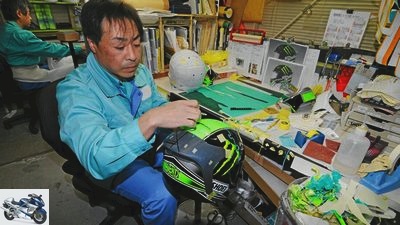
Lohse
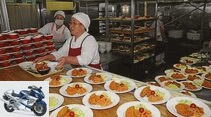
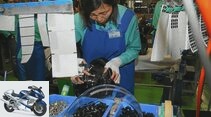
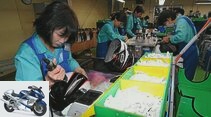
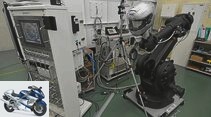
9 pictures

Lohse
1/9
Taking a break together: In the Iwate canteen, an eager kitchen crew takes care of the typical Japanese lunch.
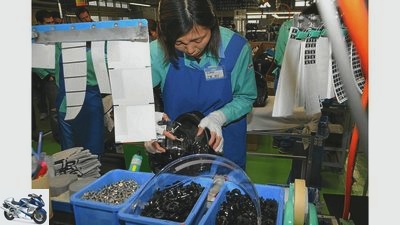
Lohse
2/9
Each Shoei helmet consists of around 50 individual parts that are put together by hand. It takes a week from the production of the raw form to the installation of the visor.
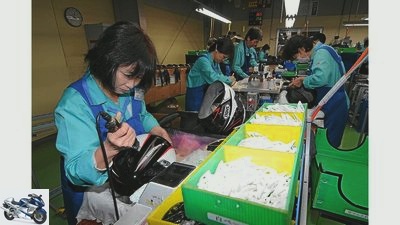
Lohse
3/9
Between the development forge and quality control, manual work dominates the production halls.
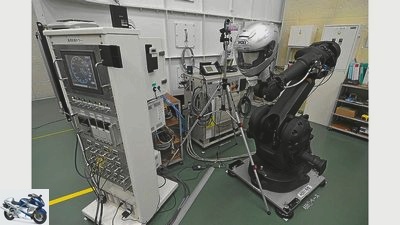
Lohse
4/9
In order to be able to compare the acoustics of the helmets exactly, robot technology is also used in the wind tunnel.
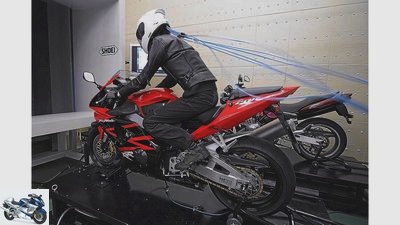
Lohse
5/9
Many driving conditions can be simulated in the new wind tunnel. Here, for example, the ventilation is measured using sensors.
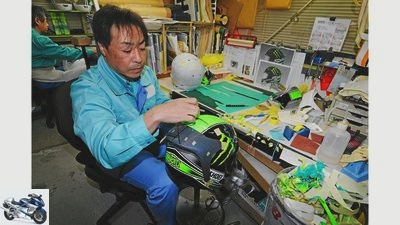
Lohse
6/9
Made in Japan – Shoei helmets have been made in Japan for over 50 years.
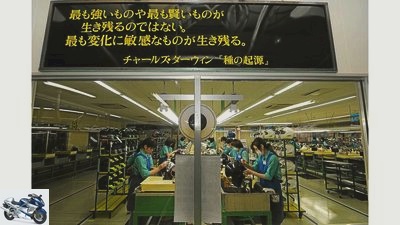
Lohse
7/9
Almost 250 people bustle through the production hall of the Japanese helmet manufacturer.
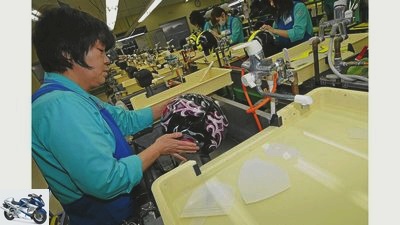
Lohse
8/9
Highly decorated: The look of each individual helmet is adjusted to the millimeter in the water bath and, after drying, is protected by a clear coat.
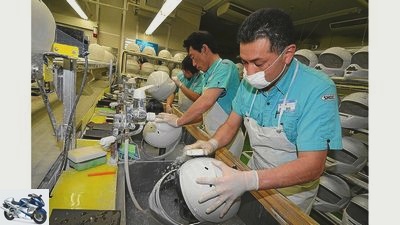
Lohse
9/9
Cleanly polished: the helmet shells are sanded off by hand between the individual priming and painting processes.
clothing
Helmets
Factory report: Shoei – Made in Japan
Factory report on Shoei helmets from Japan
Head protection from Japan
Hondas from Spain, Yamahas from Italy. Japan’s motorcycle industry has long been manufacturing all over the world. Nippon’s helmet manufacturers are much more traditional: Shoei helmets have come exclusively from Japan for over 50 years.
Jorg Lohse
02/05/2013
The small, almost 30 square meter room in the far corner of the factory is in sharp contrast to the rest of the facility: Sadamu Oikawa sits with four colleagues at stacked desks. In some corner a radio is playing the catchy tunes of Asia. But nobody bobs to the beat here. Oikawasan focuses on the helmet shell in his hands and adapts the decor microscopically. Again and again he has to snip and file until he likes the transitions on the air scoops and spoiler attachments. From a technical point of view, every Shoei helmet that leaves this room does not differ from those that are on the retailer’s shelves: proven shell, identical styrofoam dome, same upholstery materials. And yet, when it has passed through the hands of Sadamu Oikawa and his team, it is unique. Built for a racing driver who treats himself to a special look. The monster design of the Irish Superbike World Championship rider Eugene Laverty, which Oikawa-san is currently working on, is still comparatively easy to lift. Which decors are particularly tricky? Sadamu smiles thoughtfully: Kato’s were really tough. His gaze speaks volumes. He would have liked to have built a few more helmets for the sympathetic world champion from 2001, who had a fatal accident in Suzuka in 2003. The Shoei designers have to dig into the English Moto2 rider Bradley Smith, who uses up to 20 helmets during the season. Because it can take up to four weeks until the basic optics are in place. The usual time of birth of a Shoei helmet, on the other hand, takes a good working week from baking the outer shell made of a fiberglass mix to putting it in a cloth bag and cardboard box.
In addition, almost 250 people scurry through the production halls of the Japanese helmet manufacturer, whose history began in 1959 as a family company, which was about to go bankrupt in 1993, but was then restructured as a stock corporation with the help of Mitsubishi. Up here, in the province of Iwate, far north of the main island of Honshu, since production was set up in 1989, helmets have been manufactured exclusively for global export, which are then shipped in containers from Yokohama. Another factory with around 170 employees has been in operation in the province of Ibaraki (near Tokyo) since 1967, where production is now mainly for the domestic market. Two locations that are almost 400 kilometers apart and that are like an egg in terms of production technology
same as others, does that make sense? Company spokesman Moichi Tsuzuki smiles understandingly and refers to the special situation in Japan, where earthquakes are the order of the day. Should production fail in one factory, the capacities can quickly be relocated to the other.
Buy complete article
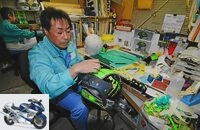
Factory report on Shoei helmets from Japan
Head protection from Japan
4 pages) as PDF
€ 2.00
Buy now
And yet Iwate and Ibaraki each have their own peculiarities: In the north, Yoshiaki Saicho takes care of the scheduled scrapping of Shoei helmets in the test laboratory. According to him, around 3,000 helmets are put on the drop test stands every year to check compliance with the various standards around the world. Recently, Saicho-san is also the proud owner of an original Sigma post from Germany. The guardrail carrier is the steel basis of every MOTORRAD helmet test. In the south of Ibaraki, on the other hand, is the research and development department of Shoei settled. Development chief Takayuki Horimoto has been able to simulate speeds of up to 230 km / h in the in-house wind tunnel since 2010 to test new helmet models. The developers have the opportunity to get an impression of prototypes for themselves (see left) or to compare the acoustics and ventilation using a specially programmed driving robot in different driving positions. The new Neotec flip-up helmet was one of the first models to be developed in the wind tunnel, which cost the equivalent of three million euros.
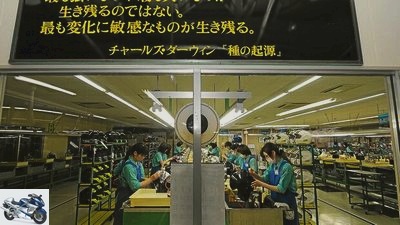
Lohse
Almost 250 people bustle through the production hall of the Japanese helmet manufacturer.
Between the development forge and quality control, manual work dominates the production halls in Iwate and Ibaraki. Automated processes run primarily in the first work steps, for example when the helmet shells made of glass and organic fibers are baked for 30 minutes – which, by the way, are used without exception in all Shoei models from beginners to racing helmets. Or when cutting out the visor and ventilation openings by laser and applying primer and various layers of paint. In between, however, a lot of manual work is required: for example when sanding and polishing between the paint applications. In addition to a lot of patience, the many women also need a good sense of proportion and a steady hand to align the logos and various decors in water transfer printing on each individual helmet shell.
After the final clear coat application, the “wedding” is finally announced: the complete assembly of the helmet with shock-absorbing EPS dome, the insertion of the also hand-sewn upholstery, the installation of the chin strap and visor including the mechanism.
All secrets revealed? Almost, there is still the question of the name: It is made up of the Showa epoch, which includes the reign of the Japanese Emperor Tenno Hirohito (1926 to 1989), and the first letter of the company founder Eitaro Kamata: Sho-Ei.
Info Shoei Co., Ltd.

Lohse
Between the development forge and quality control, manual work dominates the production halls.
Founded: 1959 by Eitaro Kamata, originally manufacturing protective helmets for construction workers
Headquarters: Tokyo / Japan
Employees: 477
Management: Hironori Yasukochi
Production: approx. 500,000 helmets / year at the Iwate and Ibaraki / Japan locations
Contact: Shoei Europa GmbH, 40595 Dusseldorf, www.shoei.com
Related articles
-
Report Factory visit Bridgestone
Plom 13th pictures 1/13 50 test motorcycles are available on the test site at the Nasu tire plant. 2/13 Long nose Lohse in the land of smiles: a radiant…
-
Travel report – motorcycling in Japan
Jorg Lohse 14th pictures Jorg Lohse 1/14 Motorcycling in Japan: Around Mount Fuji-san. Jorg Lohse 2/14 Autumn mood at Lake Motosu: the sky is gray on…
-
Driving report Aprilia RSV4 Factory
Aprilia 24 pictures Aprilia 1/24 in the superbike variant Aprilia 2/24 Aprilia RSV4 superbike. Aprilia 3/24 Aprilia RSV4 superbike. Aprilia 4/24 Aprilia…
-
Report: Royal Enfield factory visit
Horenburg motorcycles Report: Royal Enfield factory visit Report: Royal Enfield factory visit A visit to the English cult brand Royal Enfield unveiled…
-
Report: A factory visit to the brake specialist Brembo
wolf 12th pictures wolf 1/12 Laboratory check: problem cases such as brake fading are simulated on 18 test stands. wolf 2/12 Disc wheel? No, Gianluca has…
-
Shoei Japan 10 pictures Shoei Japan 1/10 This is how a Shoei helmet is made. Shoei Japan 2/10 All overhangs that have arisen during production are…
-
Report: Visit to the Magura factory
Jahn motorcycles Report: Visit to the Magura factory Report: Visit to the Magura factory Specialist in grips, brakes and handlebars At Magura, the relics…
-
Report: Riding a motorcycle in Japan
Suzuki to travel Report: Riding a motorcycle in Japan Report: Riding a motorcycle in Japan The cradle of the modern motorcycle: Through Japan by…
-
Driving report: Husqvarna TE 449 RR rally factory machine
Jahn 22nd pictures Jahn 1/22 Factory rally machine Husqvarna TE 449 RR. Jahn 2/22 Wheels: To avoid flat tires, foam rubber rings (mousse) are always used…
-
Driving report Aprilia RSV4 1100 Factory (2021)
News 2022 New motorcycle items for 2022 Marco Zamponi 12th pictures Marco Zamponi 1/12 Aprilia graciously calls the new RSV 4 Factory her Majesty. She…